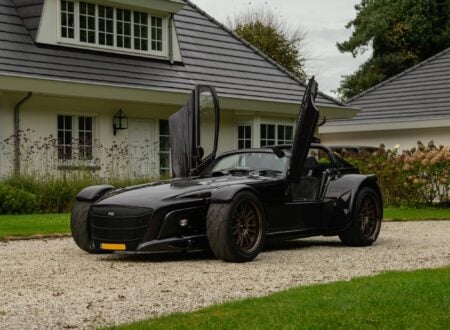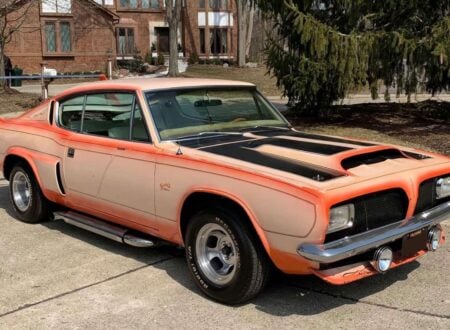This is a Holden Monaro, specifically it’s an HG Monaro GTS from the first generation of the Australian sports car’s production. It spent many years sitting in a field and has now been moved into a shipping container for safekeeping.
The owner was saving it for a rebuild, but it now offering it for sale in the hopes that someone else can invest the time and money to make the restoration happen. It’s located in Victoria, Australia and the asking price is $67,500 AUD or $45,200 USD.
Fast Facts – The Holden Monaro GTS
- The Holden Monaro, first introduced in 1968, was Australia’s answer to American cars like the Ford Mustang and Chevrolet Camaro. The name “Monaro” was serendipitously discovered by Holden designer Noel Bedford during a holiday road trip when he saw “Monaro County Council” on a sign in the countryside.
- The specific car in the article is an HG Monaro GTS 186, part of the first-generation series produced from 1968 to 1971. These early Monaros, which included the HK, HT, and HG models, are highly sought after by collectors, typically fetching prices well into the six figures.
- The HG Monaro GTS shown in this article has been stored in a shipping container in Yarck, Victoria, for years. The owner has accumulated numerous parts for restoration, including original black door trims, glass, guards, an original GTS bonnet, front ends, an LSD differential, seats (needing a re-trim), dashes, grills, and multiple engines (350 Chevrolet V8 engines and a 400 block with heads).
- The owner, who had intended to restore the car, is now offering it for sale due to a lack of time to complete the project. The asking price is $67,500 AUD (approximately $45,200 USD).
The First Generation Holden Monaro
The Holden Monaro debuted in 1968 as a homegrown Australian answer to American pony cars like the Ford Mustang and Chevrolet Camaro. It would be offered with both straight-six and V8 engine options, with the most powerful variant initially getting the 327 cubic inch Chevrolet V8.
 Art the time of its release, and for many years afterward, the Holden Monaro was one of the most exciting locally-produced sports cars in Australia. Image courtesy of Holden.
Art the time of its release, and for many years afterward, the Holden Monaro was one of the most exciting locally-produced sports cars in Australia. Image courtesy of Holden.The “Monaro” name worked so perfectly alongside Camaro, its General Motors sibling from the USA, that it could have been dreamed up by a particularly fruitful all-hands marketing meeting at Holden. But it wasn’t. The name was stumbled across entirely by accident by a technical stylist and member of Holden’s design team named Noel Bedford when he was on holiday.
It was late 1967 and Holden’s all-new sporting coupe was merely nine months from launch, and it was still without a name. Hundreds of suggestions had been made but none of them had stuck, the closest had been the name “Torana,” and this was used for a number of the upcoming car’s clay models, but as it played out the time for that name hadn’t quite yet come.
Noel Bedford’s holiday had started much like any other, he was on a road trip tour of Australia’s South Eastern region around the Snowy Mountains. It would be here when driving through the town of Cooma, New South Wales, that he noticed a sign on the council offices.
This sign read “Monaro County Council” and it had been professionally painted in a classic “Old West” type font. The name Monaro seemed like a perfect union of Marlboro Country and Camaro, Bedford made a note of it and was later quoted as saying: “It seemed to me so simple and logical. Why didn’t somebody think of it before? I was quite excited and couldn’t wait to get back to work.”
When he did get back to work his colleagues loved the name, it was quickly checked for copyright, and the names etymology was researched. As it happens the name Monaro is of Aboriginal origin, meaning a “high plateau” or “high plain,” a perfect choice then for Holden’s new sports car that they hoped would enjoy high sales figures.
The first generation Monaro would be built from 1968 until 1971 across three major variants – the HK, HT, and HG. All three of these used fundamentally the same body shell, but came with various cosmetic changes, some additional engine options, and further refinements.
 The Monaro was advertised extensively in period motoring magazines and it sold well, well enough for multiple generations to follow it, though none of these ever achieved the same cult-like status as the original. Image courtesy of Holden.
The Monaro was advertised extensively in period motoring magazines and it sold well, well enough for multiple generations to follow it, though none of these ever achieved the same cult-like status as the original. Image courtesy of Holden.These first generation Monaros are now by far the most desirable in the eyes of collectors and enthusiasts, with the valves of restored examples selling for well into the six figures.
Though a small number of Monaros have been exported to the USA and Europe they remain largely unknown outside of their native Australia.
The Holden Monaro GTS Shown Here
The car you see here has been placed into a shipping container for preservation on a property in the rural town of Yarck in Victoria, Australia. The current owner, and now seller, explains that the car is an HG Monaro GTS 186 and that it comes with many additional parts:
“…original black door trims in very good condition, lots of trims, glass, guards, bonnets, original GTS bonnet, front ends, LSD diff, two sets of seats need re trim, Dashes and grills. 350 Chev engines x 2, 400 block and heads…”
 As the listing notes, this Monaro project car comes with a shipping container full of parts, including the original engine, two additional engines, and the block and heads of a 400 cubic inch V8.
As the listing notes, this Monaro project car comes with a shipping container full of parts, including the original engine, two additional engines, and the block and heads of a 400 cubic inch V8.It’s clear that this car will be a major project, but it does look doable for someone with the right skills, plenty of patience, and deep enough pockets.
It’s being offered for sale on Facebook Marketplace with an asking price of $67,500 AUD or $45,200 USD and you can visit the listing here if you’d like to read more about it or register to bid.








Images courtesy of Facebook Marketplace








